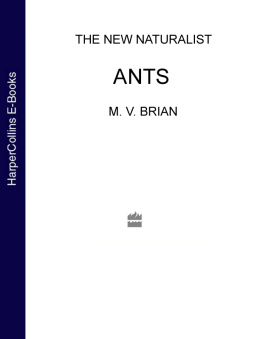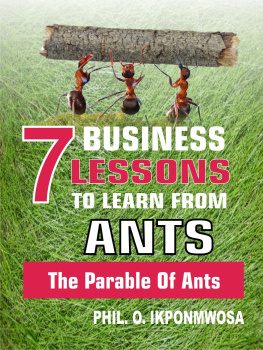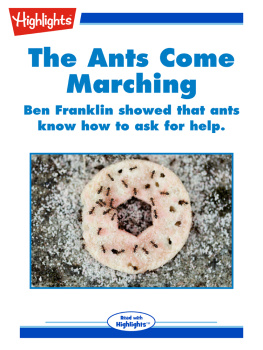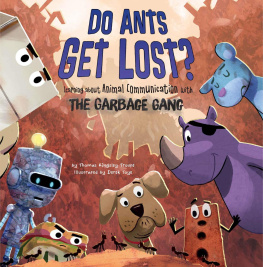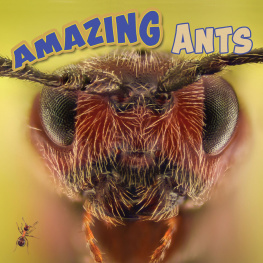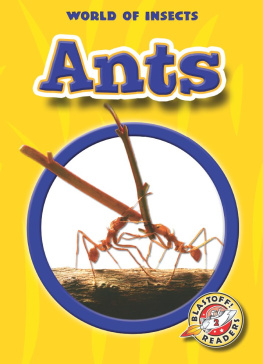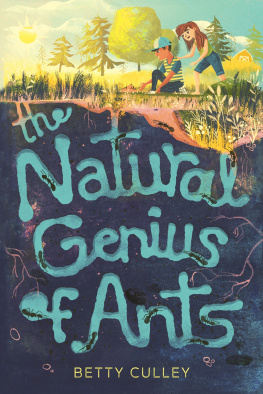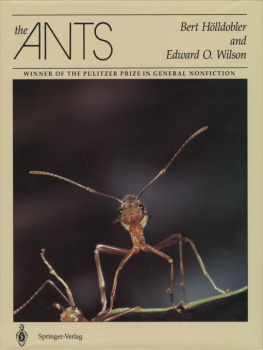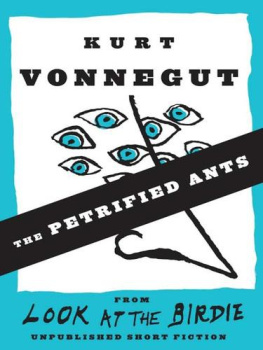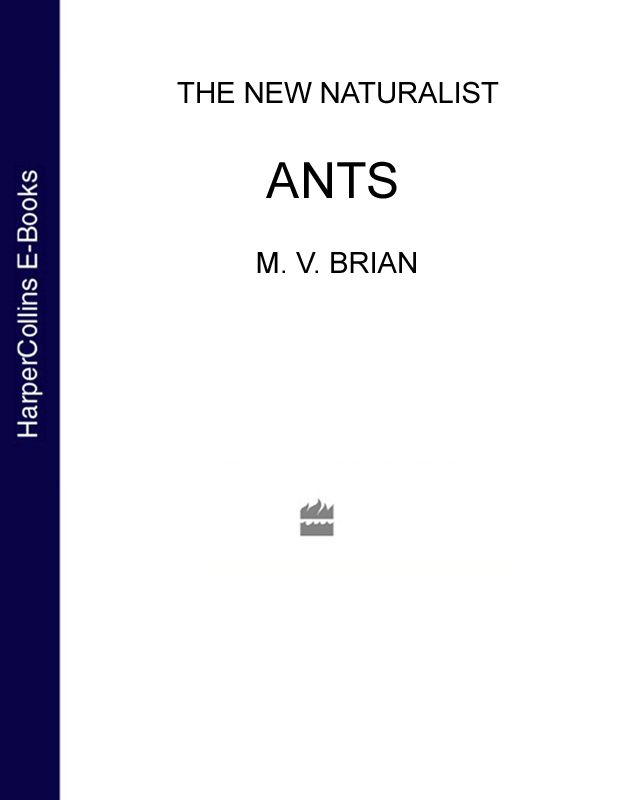EDITORS:
John Gilmour M.A. V.M.H.
Margaret Davies D.Sc.
Kenneth Mellanby C.B.E. Sc.D.
PHOTOGRAPHIC EDITOR:
Eric Hosking O.B.E. Hon. F.R.P.S. F.I.I.P.
The aim of this series is to interest the general reader in the wild life of Britain by recapturing the inquiring spirit of the old naturalists. The editors believe that the natural pride of the British public in the native fauna and flora, to which must be added concern for their conservation, is best fostered by maintaining a high standard of accuracy combined with clarity of exposition presenting the results of modern scientific research.
William Collins
An imprint of HarperCollinsPublishers Ltd
1 London Bridge Street
London SE1 9GF
WilliamCollinsBooks.com
This eBook edition published by William Collins in 2018
M. V. Brian
The author asserts his moral rights to be identified as the author of this work
A catalogue record for this book is available from the British Library.
All rights reserved under International and Pan-American Copyright Conventions. By payment of the required fees, you have been granted the non-exclusive, non-transferable right to access and read the text of this eBook on-screen. No part of this text may be reproduced, transmitted, downloaded, decompiled, reverse engineered, or stored in or introduced into any information storage and retrieval system, in any form or by any means, whether electronic or mechanical, now known or hereinafter invented, without the express written permission of HarperCollins Publishers.
HarperCollinsPublishers has made every reasonable effort to ensure that any picture content and written content in this ebook has been included or removed in accordance with the contractual and technological constraints in operation at the time of publication.
Source ISBN: 9780007308378
Ebook Edition DECEMBER 2018 ISBN: 9780007406470
Version: 2019-01-09
CONTENTS
facing page
Painted by Gordon Riley
facing page
This series has always tried to give a balanced and authoritative account of a subject of interest to the general reader who is concerned with the countryside, and who wishes to know more about its fauna and flora. In Dr M. V. Brian we have an author who is recognized as the foremost authority in Britain on ants. Over a period of nearly thirty years, first as a lecturer in zoology in the University of Glasgow, and since 1953 with the Nature Conservancy at Furzebrook Research Station in Dorset, he has studied social insects in general and ants in particular. His most intensive studies in recent years have been on the heathlands of southern England, but he is also familiar with the species restricted to other parts of the country. He has written more than seventy original scientific papers describing his research, and has clearly contributed greatly to the advancement of knowledge of this group.
Since biblical days, ants have interested the general public as well as the specialist entomologist. The insects apparent industry has endeared them to the moralist, and has been equated with virtue and prudence in the fables of many cultures. Parables based on ants are thus widespread, not only in scripture but in the tales of such writers as Aesop and La Fontaine. This has given rise to a general belief that ants are beneficial insects whose presence should always be encouraged. On the other hand gardeners from their own observations may be more doubtful, particularly when ants invade and infest their houses. Picnickers in our woods who sit near or even on an ant hill may feel rather differently. All country dwellers are aware of ants, but few have any accurate information on the subject, and many widely accepted legends have little foundation in fact. We believe that this book will therefore fill a real demand, by giving the sort of information that has so far been difficult to obtain.
Dr Brian draws continually in his text on his personal experiences and on the brilliant investigation he himself has made. At the same time he would be the first to insist that no one person could do more than a fraction of the research necessary for the writing of a book like this. He clearly has to depend on the work of many others, and the reader will notice that though he treats others findings with the same rigorous criticism he reserves for his own observations, he also gives them the fullest credit when it is deserved. He has therefore produced a readable and informative book which describes the nature and behaviour of ants and their importance in the ecology of our countryside.
This book is about the natural history of the ants that occur in the British Isles. Most of the species have wide temperate Eurasian distributions and, though unspectacular compared with some tropical types, play an important part in terrestrial ecosystems. The book attempts to bring together much recent work on their ecology and general biology and is, I hope, written in a way that will interest and be of use to all naturalists.
A reading list is added to guide anyone who wishes to go further. No references are given and I am thus particularly indebted to the many workers in this field whose publications have supplied the basic material of this book. Technical names for structural features are explained in a series of figures, the main elements of which have been extracted from Charles Janets detailed drawings published at the turn of the century.
At the last moment it was possible to improve the book enormously by including distribution maps prepared by the Biological Records Centre. The information was collected and collated by Mr K. E. J. Barrett, who introduces them.
I should like to thank my wife for reading the manuscript and discussing it with me.
M. V. Brian
November 1976
Furzebrook, Wareham, Dorset
ALL ants are social insects but only in the female sex; males exist briefly to generate sperm for sexual reproduction. Females are of two distinct sorts. One is relatively large and designed to fly and seek out new places in which to live; she lays fertilized eggs and influences the manner of brood-rearing in the colony. The other is smaller and wingless with a much simpler form altogether; she devotes most of her time to nest making and defence, brood hygiene and feeding and, later in life, to collecting food outside the nest. As ant societies last a long time and make easily defended nests that are climatically equable it is possible for the young to be legless grubs, but whether they have evolved from a normal six-legged state or whether they were already legless in a pre-social evolutionary stage, perhaps as parasites, is uncertain. They can do little more than arch their bodies, suck and digest the food that the adults give them, and urinate. They are, however, well designed for growth and when, after several moults to allow for expansion, they have stored enough raw materials, all their food residues are ejected at one go and the buds of the rudimentary adult inside grow and join up. After one more moult a further metamorphosing stage is produced (the pupa) from which the final adult later emerges.
In the tropics ants have evolved enormous societies with nearly every conceivable way of living in the terrestrial habitat. Many thousands of species are already known and more doubtless remain to be discovered. Here in north-west Europe ants are by no means so spectacular but their social organization is impressive. They live nearly everywhere and play an important part in natural processes.

